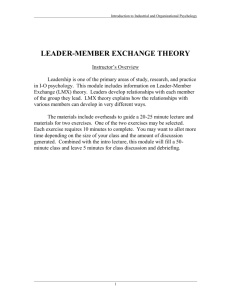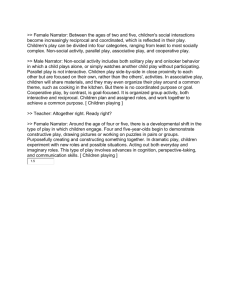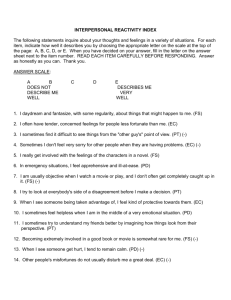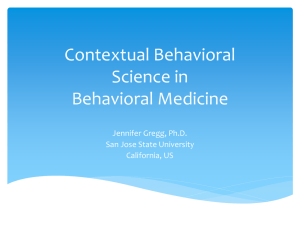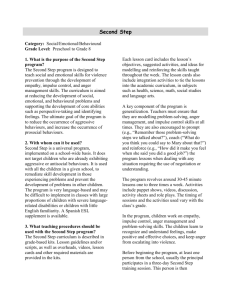Perspective-taking as an organizational capability Article
advertisement
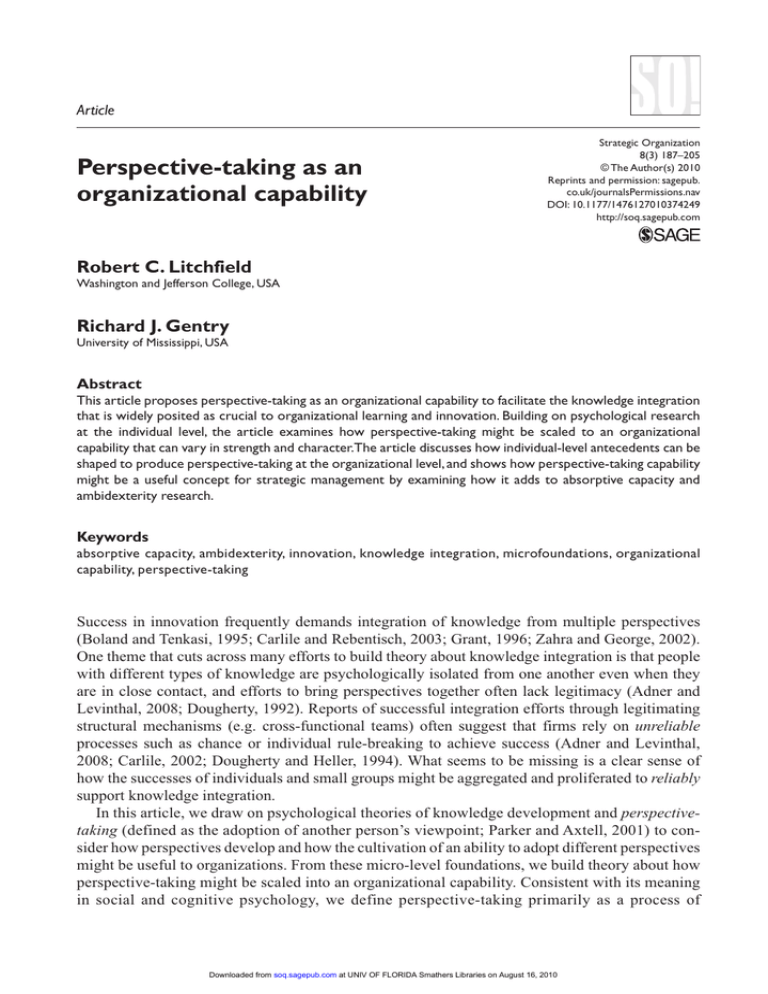
Article Perspective-taking as an organizational capability Strategic Organization 8(3) 187–205 © The Author(s) 2010 Reprints and permission: sagepub. co.uk/journalsPermissions.nav DOI: 10.1177/1476127010374249 http://soq.sagepub.com Robert C. Litchfield Washington and Jefferson College, USA Richard J. Gentry University of Mississippi, USA Abstract This article proposes perspective-taking as an organizational capability to facilitate the knowledge integration that is widely posited as crucial to organizational learning and innovation. Building on psychological research at the individual level, the article examines how perspective-taking might be scaled to an organizational capability that can vary in strength and character.The article discusses how individual-level antecedents can be shaped to produce perspective-taking at the organizational level, and shows how perspective-taking capability might be a useful concept for strategic management by examining how it adds to absorptive capacity and ambidexterity research. Keywords absorptive capacity, ambidexterity, innovation, knowledge integration, microfoundations, organizational capability, perspective-taking Success in innovation frequently demands integration of knowledge from multiple perspectives (Boland and Tenkasi, 1995; Carlile and Rebentisch, 2003; Grant, 1996; Zahra and George, 2002). One theme that cuts across many efforts to build theory about knowledge integration is that people with different types of knowledge are psychologically isolated from one another even when they are in close contact, and efforts to bring perspectives together often lack legitimacy (Adner and Levinthal, 2008; Dougherty, 1992). Reports of successful integration efforts through legitimating structural mechanisms (e.g. cross-functional teams) often suggest that firms rely on unreliable processes such as chance or individual rule-breaking to achieve success (Adner and Levinthal, 2008; Carlile, 2002; Dougherty and Heller, 1994). What seems to be missing is a clear sense of how the successes of individuals and small groups might be aggregated and proliferated to reliably support knowledge integration. In this article, we draw on psychological theories of knowledge development and perspectivetaking (defined as the adoption of another person’s viewpoint; Parker and Axtell, 2001) to consider how perspectives develop and how the cultivation of an ability to adopt different perspectives might be useful to organizations. From these micro-level foundations, we build theory about how perspective-taking might be scaled into an organizational capability. Consistent with its meaning in social and cognitive psychology, we define perspective-taking primarily as a process of Downloaded from soq.sagepub.com at UNIV OF FLORIDA Smathers Libraries on August 16, 2010 188 Strategic Organization 8(3) internally imagining the viewpoint of another. Such a process may and, perhaps, should involve communication across perspectives, but this is not required (cf. Boland and Tenkasi, 1995: 358). We emphasize perspective-taking as a process of motivated, situational cognition (Barsalou, 2008) that facilitates specific social bonds among all sorts of people, whether or not they possess specialized knowledge (Galinsky et al., 2005). Consistent with such a characterization, we focus on factors that are relatively independent of the process of individuals and groups identifying their own knowledge and its limitations (cf. Boland and Tenkasi, 1995). Our view is that all organizational members are capable of perspective-taking and yet usually do not engage in it (cf. Boland and Tenkasi, 1995). Because we cast organizational perspective-taking capability as involving discretionary activity to support knowledge integration, our proposal requires explicit acknowledgment of this motivational breakdown. Felin and Foss (2005, 2006) observed that processes for aggregating micro-level phenomena into macro-level processes in organization studies are often underspecified. We contribute to the literature concerned with the knowledge integration aspect of organizational learning by explaining how the psychological process of perspective-taking might be scaled into an organizational capability to support knowledge integration efforts. We begin by discussing the development of perspectives and perspective-taking in individuals. Next, we detail perspective-taking as an organizational capability. We conclude the article by examining how a perspective-taking capability might contribute to other research streams in strategic organization. Perspectives and perspective-taking in individuals A perspective, or point of view, implies some combination of perception and knowledge that is organized to meet a goal. For instance, an entrepreneur’s perspective on a neighborhood cafe might organize perceptions of the physical setting (e.g. traffic and location) with knowledge of the cafe’s operating costs in order to make a judgment about whether the cafe is a desirable business to purchase and expand to include a bar for evening revenue. A manager’s perspective on the cafe might organize these same pieces of knowledge but arrive at a different conclusion about the desirability of adding a bar because of concerns about the complexities of managing day and evening businesses in the same location. An academic might note that cafes and bars are among the businesses most likely to fail. Research on knowledge development in individuals provides an interesting window on the development of perspectives. Although many details are open to debate, psychologists generally agree that knowledge is represented in memory in terms of cases, or exemplars, based on our prior experience of the world, and in terms of larger structures called categories that identify groups of exemplars. Defining an exemplar in a psychologically precise manner can be tricky (Murphy, 2002), but exemplars essentially correspond to instances of experience rather than distinct physical or conceptual entities (Nosofsky, 1988). As a consequence, an individual’s knowledge of a given domain may look very different depending upon the structure of his or her prior experiences. For instance, a manager who works in the same cafe for a year is building up a set of exemplars for the category ‘cafe’, and even for a more abstract knowledge structure such as ‘how a small business functions’ that may be equal in size to a set of exemplars built by an entrepreneur who sees several different cafes over that time frame. Although people do separately identify individuals (i.e. cafes), it is likely that the influence of frequency of prior exemplars persists when judgments are made (Barsalou et al., 1998). Thus, our hypothetical manager and entrepreneur may think and act as if they have equivalent knowledge of ‘how a small business functions’, though the content and consequences of their thoughts and actions will likely differ. Downloaded from soq.sagepub.com at UNIV OF FLORIDA Smathers Libraries on August 16, 2010 189 Litchfield and Gentry Because each individual is exposed to different sets of perceptual experiences, often with different goals, each builds different knowledge. Thus, even when people seem to have much in common, their perspectives may differ substantially. Differences between individuals’ perspectives may be even larger when they experience systematically divergent environments. One relevant example of systematic differences occurs when people develop expertise in a common domain through different professional paths. Perspectives derived through a profession may share many commonalities due to similarities in initial training, perceptual experience on the job and the goals of the profession. Importantly, such perspectives might differ markedly from others within the same domain that developed through a different professional pathway. For example, managers might hold views of management that systematically differ from those of academics who study management. Although one might argue that these differences would disappear at the highest knowledge levels, research involving different types of experts within the same domain suggests that differing goals of professional specialties create differences in the structure of knowledge even among experts (Lynch et al., 2000; Medin et al., 1997). Therefore, even experts might systematically diverge in their judgments on the prospects of a given cafe or more generally on the keys to performance of a new venture. Because the type of knowledge obtained from multiple perspectives does not necessarily converge as the level of knowledge increases, considering different perspectives on a given phenomenon might yield important insights not obtainable from a single perspective. In organizations, identifiable perspectives are often associated with organizational or professional roles. This connection of perspectives to roles suggests that perspectives in organizations will often be recognized at the group level of analysis (Boland and Tenkasi, 1995; Carlile, 2002; Dougherty, 1992). Indeed, some critical mass of strength in numbers, hierarchical power, personal attributes, network position, or specialized knowledge may be a prerequisite for any given perspective to be said to exist in an organization. Many scholars have noted that differences in perspectives can simultaneously spur and limit organizational learning and innovation (e.g. Boland and Tenkasi, 1995; Carlile, 2002, 2004; Dougherty, 1992). Clashes among perspectives can be resolved in many ways, from brute force applications of power to delicate negotiations to tacit avoidance. At the individual level, one mechanism for resolving such differences that has received sustained research attention is perspective-taking. The process of taking another’s perspective is usually construed as an imaginative process (e.g. what would it be like to stand in another’s shoes?) and, if we return to our opening cafe example for a moment, we can easily confirm that we can place ourselves mentally in the shoes of a customer, owner, or manager. The imaginative process might be even easier if we were to stand behind the counter or sit in the owner’s office (Storms, 1973). As a cognitive process of imagining oneself in another’s shoes, perspective-taking has often been considered conceptually distinct from affective processes such as empathy or perceptual processes that accompany changes in one’s physical location or direct communication with others, but these distinctions are sometimes blurred in practice (e.g. Parker and Axtell, 2001; Storms, 1973). At other times, cognitive, affective and perceptual perspective-taking are empirically separated but then claimed to be conceptually related (e.g. Galinsky et al., 2006). Construed broadly, perspective-taking might be seen to encompass affective, perceptual and cognitive dimensions. Indeed, recent theory integrating affect, perception and knowledge suggests that perspective-taking may be a form of situationally motivated, or grounded cognition (Barrett, 2006; Barsalou, 2008). Theories of grounded cognition propose that people imagine both perceptual and attitudinal phenomena by enacting simulations that organize prior knowledge according to some perspective-related goal (Barsalou, 1999; for a Downloaded from soq.sagepub.com at UNIV OF FLORIDA Smathers Libraries on August 16, 2010 190 Strategic Organization 8(3) review, see Barsalou, 2008). To the extent that people do not have direct experience of a perspective, they imagine it based on related knowledge they do possess (Barsalou, 1999). In the cafe example, we mentally simulate what it is like to survey the cafe as a manager or prospective owner would by drawing on our knowledge of what is important to managers or entrepreneurs. Supporting this view of perspective-taking as enactment of simulations based on perceived knowledge, researchers have found that perspective-taking is somewhat effective at capturing other perspectives (e.g. Epley et al., 2004; Galinsky and Moskowitz, 2000). That is, perspectivetaking can reduce but does not necessarily eliminate stereotyping and other biases in adjustments from one’s own knowledge to the knowledge of others (Galinsky and Moskowitz, 2000; Epley et al., 2004). Perspective-taking is imperfect, but it improves when people are highly motivated to be accurate (Epley et al., 2004). Because perspective-taking relies on perceived knowledge about the other perspective, one can also expect that the knowledge level about the other perspective (but not necessarily knowledge level about the domain; cf. Nückles and Bromme, 2002) would impact the accuracy of perspective-taking.1 Indeed, even as perspective-taking sometimes reduces stereotypes, perspective-takers who have little specialized knowledge also have been shown to rely on stereotypes to provide knowledge about another perspective (Galinsky et al., 2008c). Following Barsalou’s (1999) proposal that people use the knowledge they have, laypersons asked to adopt an academic’s perspective on the cafe might be expected to confound this perspective with those of managers, entrepreneurs, or even customers (e.g. ‘professors like coffee!’), leading to poor accuracy in perspective-taking. Despite its imperfections, perspective-taking has been shown to produce a range of interesting outcomes that share a common theme of improved cooperation between perspective-takers and others whose perspectives are taken (for a review, see Galinsky et al., 2005). For instance, Parker and Axtell (2001) showed that employees who adopted the perspective of internal suppliers (other employees of the same firm) engaged in more cooperative behaviors toward these suppliers. Parker and Axtell (2001) also found that taking the perspective of one’s supplier had no effect on behavior toward members of the perspective-taking employees’ own team. This finding is important because it illustrates the target-specific nature of perspective-taking (Galinsky et al., 2005). Perspective-taking promotes only consideration of specific alternative views and is not a more general mechanism to encourage either alternative consideration or the formation of social bonds in organizations. Galinsky et al. (2005) envision perspective-taking as an important mechanism to form specific social bonds and thereby facilitate social coordination. If scalable, such a mechanism could form an important capability to deliver on the promise of knowledge integration. From individual to organization: Perspective-taking as an organizational capability Organizational capabilities are patterned activity oriented to specific objectives (Winter, 2003). Like knowledge or skill sets at the individual level, capabilities imply a certain level of reliability in response production (Gavetti, 2005). Like routines, capabilities are detailed and specific in their operation (Eisenhardt and Martin, 2000). But whereas routines may often be task-specific, capabilities operate at a level of abstraction sufficiently higher than the individual task such that they provide management ‘a set of decision options for producing significant outputs of a particular type’ (Winter, 2003: 991). Thus, capabilities can be generalized across multiple routines (Winter, 2003). The presence of both a general and a specific component in perspective-taking suggests a potential fit with the idea of a capability. Perspective-taking in individuals is a general ability to adopt others’ viewpoints, but it is not a general tendency to do so. Rather, perspective-taking occurs when Downloaded from soq.sagepub.com at UNIV OF FLORIDA Smathers Libraries on August 16, 2010 191 Litchfield and Gentry there are specific others whose views are considered by the perspective-taker to be salient to some objective (Galinsky et al., 2005). Perspective-taking is motivated cognition, and thus potentially manageable. One interesting indication of the potential utility of articulating perspective-taking as a capability is the evidence that firms often seem to lack a mechanism to engage this pattern of activity with any reliability. In two separate streams of research, Dougherty (1992; Dougherty and Heller, 1994) and Carlile (2002, 2004; Carlile and Rebentisch, 2003) and their colleagues have clearly articulated the importance of and barriers to knowledge integration in innovation. Most of this research focuses on finding ways for specialist groups to represent their knowledge to others or, alternatively, to reflect on the boundary between their own knowledge and that of others (cf. Boland and Tenkasi, 1995; Carlile, 2002; Carlile and Rebentisch, 2003; Dougherty, 1992). Important as this activity is, we argue that it is incomplete without consideration of how and whether individuals and groups posit the views of others. Each stream contains examples of how either perspectivetaking or the failure to engage in it affected knowledge integration. Consider this statement from Dougherty and Heller’s (1994) study of innovation in established firms: The big issue is when I tell research people what I need in the marketplace, they don’t believe it. I kept telling them that I couldn’t sell that polymer in this market, and they kept coming back with the same polymer. Finally, I wrote out a three-page memo detailing all the attributes I needed. Then I took Fred and Bob out and introduced them to customers, and sat down with customers. . . . Suddenly, everything I’ve been saying they now say we need. (Dougherty and Heller, 1994: 209) In this vignette, Dougherty and Heller (1994) report on a successful use of forced perspectivetaking as a kind of last resort. Only when forced did research personnel adopt the perspective of the salesperson. Now consider Carlile’s (2002: 449–50) ‘across-boundary’ vignette, in which a manufacturing engineer (Mick) tries to communicate with design engineers about problems in the design of a valve: In the next OVRV design and review meeting, Mick made the same points, but now with an up-to-date assembly drawing that reflected the current design. Mick’s arguments were no different from the ones he had made before, but they had a very different impact now that the assembly drawing reflected the specs, tolerances and locations of critical sealing surfaces that were ‘at stake’ for the design engineers. (Carlile, 2002: 450) Here, no perspective-taking happens, and knowledge integration only begins when a document (a ‘boundary object’ for Carlile, 2002) is presented that represents knowledge that independently allows the same conclusion from each perspective. Although Carlile (2002) has certainly touched on an important source of knowledge integration in his discussion of boundary objects, his analysis also notes that this document comes into existence very late in the innovation process. Perspective-taking might provide an independent path to knowledge integration that, far from a last resort or a downstream consequence of the creation of boundary objects, could serve as a partial organizer of knowledge integration activities. In addition to the possibility that boundary objects facilitate perspective-taking (Boland and Tenkasi, 1995), we propose that an organizational capability in perspective-taking might aid in the identification of candidate boundary objects. Framing perspective-taking as a capability also implies that it may develop, which suggests variance within organizations over time and, at a given time, variance across organizations. Downloaded from soq.sagepub.com at UNIV OF FLORIDA Smathers Libraries on August 16, 2010 192 Perceived similarity Interpersonal contact Prosocial goal relevance Perceived inadequacy of cognitive or affective perspectivetaking Access to an inquiry mechanism Cognitive perspectivetaking Affective perspectivetaking Integration achieved using power applied through force Goal relevance Salience and interpretation of integrative goals influenced through power Awareness of other perspectives Perspectivetaking organizational capability Perceptual perspectivetaking Reenforcing mechanisms using power applied through dominance and discipline Strategic Organization 8(3) Individual Maintaining perspectivetaking as a capability Organizational Outcomes: • Knowledge integration • Organizational ambidexterity • Absorptive capacity Organizational Figure 1. A model of perspective-taking as an organizational capability At the individual level, research shows that perspective-takers may use stereotypes of other perspectives to guide their judgments (Galinsky et al., 2008c), but perspective-taking can also reduce stereotyping (Galinsky and Moskowitz, 2000) and improve information use (Epley et al., 2004). Because stereotypes represent commonly held beliefs about another perspective, this research also indirectly suggests that individuals and, perhaps, firms might become more sophisticated in their perspective-taking as they develop better knowledge from multiple viewpoints. Better knowledge within the firm about various perspectives furthers the knowledge-based view of the firm’s emphasis on coordination, learning and identity (Kogut and Zander, 1996). Evidence of both stereotyping and its reduction through learning across perspectives is available in prior accounts of knowledge integration in innovation teams (e.g. Carlile, 2002; Dougherty, 1992; Dougherty and Heller, 1994). This variation suggests that perspective-taking might differ in its strength and character across firms and across time as individual firms’ capabilities develop. Overall, we think that perspective-taking demonstrates meaningful indications of a potential capability that has clear microfoundations in individual-level social cognition. Figure 1 presents our model, which we describe in the following pages. Dimensions of perspective-taking One reason that a perspective-taking capability might vary across firms and across time is that individual perspective-taking has been discussed in terms of cognitive, affective and perceptual Downloaded from soq.sagepub.com at UNIV OF FLORIDA Smathers Libraries on August 16, 2010 193 Litchfield and Gentry dimensions, and the ‘patterned activity’ (Winter, 2003) of a capability could coalesce around different combinations of these dimensions. In this section, we briefly describe each dimension (see also Figure 1). Cognitive perspective-taking. The cognitive dimension, which is most frequently articulated as the conceptual core of individual perspective-taking (Galinsky et al., 2005; Parker and Axtell, 2001), retains a central role in an organizational capability. Organizations might be said to engage in cognitive perspective-taking when they have established patterns of action where members routinely consider specific other perspectives that are relevant to their work, imagine how the holders of those perspectives think, and then either take these views into account or make a decision to ignore them after consideration. Cognitive perspective-taking is an imaginative process that may benefit from, but does not require solicitation of another’s perspective. A question associated with this dimension is ‘How do they think about this and how is that relevant to us?’ The cognitive dimension of perspective-taking has, perhaps, received more attention in organizational settings relative to other dimensions. Existing research shows that organizational participants frequently do know something about the knowledge of others from different specialties, even if they do not use this knowledge (Carlile, 2002; Dougherty, 1992; Dougherty and Heller, 1994). For instance, Dougherty (1992) notes that people are aware of the concerns of other perspectives (thought worlds, for Dougherty), but they largely choose not to relate to them. The cognitive dimension of perspective-taking taps this knowledge of other perspectives. Affective perspective-taking. Organizations might be said to engage in affective perspective-taking when they have established patterns of action where members view other perspectives as legitimate and worthy of respect. A question associated with this dimension is ‘How do they feel about this and how can we show respect for their feelings?’ Affective perspective-taking is important because it is a mechanism for prosocial integration across perspectives. Indeed, prosocial motivation, which refers to ‘concern for others’, can cause perspective-taking (Grant and Berry, in press). Although affect has been posited in terms of cognition (for review, see Barrett, 2006), affective perspective-taking clearly makes use of different knowledge and goals from cognitive perspectivetaking (Galinsky et al., 2008a). At higher levels of analysis, it has long been recognized that organizations may develop cultures that emphasize knowledge of and respect for others’ feelings while remaining relatively low in behaviors that might be associated with cognitive perspective-taking (e.g. Lawrence and Lorsch, 1967). Perceptual perspective-taking. Perceptual perspective-taking in individuals involves taking perceptual vantage points of others (e.g. Storms, 1973). Organizations might be said to engage in perceptual perspective-taking when they have established patterns of action where members routinely use communication and information systems (cf. Boland and Tenkasi, 1995) or other perceptual devices to inquire about other perspectives. For instance, members of one group might construct a dashboard of metrics used by another perspective in order to ‘see’ from this view. Alternatively, people might directly ask others to describe their perspectives (e.g. Shelton and McNamera, 2004). The example given earlier from Dougherty and Heller’s (1994) work, in which customers are asked to describe their perspective to research people, illustrates this strategy. A question associated with perceptual perspective-taking is ‘How do they perceive this and how does it differ from our view?’ Perceptual perspective-taking is important because it is a mechanism for inquiring across perspectives. This mechanism of active inquiry highlights the fact that perspective-taking can be, but does not have to be an isolated cognitive or affective exercise. Perceptual perspective-taking may be useful to unearth boundary objects where adjustments from one perspective to another can be Downloaded from soq.sagepub.com at UNIV OF FLORIDA Smathers Libraries on August 16, 2010 194 Strategic Organization 8(3) experienced (cf. Boland and Tenkasi, 1995; Carlile, 2002). An interesting question is whether perceptual perspective-taking can exist in the absence of cognitive or affective perspective-taking. In principle, it seems possible that organizational members could solicit information on others’ perspectives out of mere procedural compliance, without considering them in any way. Yet as we note in the next section, this is probably not likely to result in development of a useful capability. Consequences of a perspective-taking capability Our discussion of perspective-taking capability suggests that the major proximal consequence of this capability is improved knowledge integration, a process whereby knowledge of multiple specialists is transformed into something usable by the firm as a whole (Carlile, 2004; Grant, 1996). Knowledge integration has been viewed as particularly critical to firm innovation and performance in fast-moving industries (Grant, 1996), perhaps because it is in these situations where the most novel changes occur between the time that prior knowledge is stored and the time at which it is retrieved for use (Carlile and Rebentisch, 2003). As Figure 1 shows, perspectivetaking capability might also have implications for related concepts such as absorptive capacity (Cohen and Levinthial, 1990) and ambidexterity (Benner and Tushman, 2003). We discuss these issues later in the article. Not all knowledge to be integrated in organizations is technical knowledge, and not all possible integrations of knowledge (technical or otherwise) are likely to lead to positive firm performance. The mix of perspective-taking dimensions (i.e. affective, cognitive, perceptual) embodied in a particular firm’s capability could conceivably result in a range of effects on the amount and quality of knowledge integration. For instance, a firm with a disproportionate endowment of affective perspective-taking might be a very positive place to work in some ways, but one could imagine that too much empathy might be wasteful as different knowledge perspectives seek to achieve consensus out of respect for others beyond the point of any real value-added. Though some form of knowledge integration might be facilitated in this scenario, its effects may be of relatively low value. A longer term consequence of this sort of pattern might be to interfere with the perspectivemaking activities that are critical for the development of specialized knowledge in a firm (Boland and Tenkasi, 1995). Thus, a capability too heavily weighted toward affective perspective-taking might undermine knowledge integration in the short run and over longer periods. Too little affective perspective-taking relative to cognitive perspective-taking might also lead to low-value knowledge integration if it causes different knowledge communities to engage in perspective-taking only to further their own goals at the expense of others (Galinsky et al., 2008a). Both affective and cognitive perspective-taking must be sufficiently supported by perceptual perspective-taking in order for communication across perspectives to be able to be used in a planned way to uncover integrative solutions and boundary objects that facilitate them (Boland and Tenkasi, 1995; Carlile, 2002). Yet perceptual perspective-taking can also be too strong relative to other dimensions. For instance, it is relatively easy to imagine a firm in which inquiring into others’ perspectives becomes an expected routine that is not supported by any real perceptions of its value on the part of the inquirers. Such perfunctory perspective-taking seems unlikely to yield benefits. All of this suggests that perspective-taking dimensions do not necessarily work as independent, additive effects to produce a capability. One particularly important combination is the joint development of cognitive and affective perspective-taking. Dougherty (1992) suggests that collective action is necessary to overcome institutional barriers to new product innovation, and affective perspectivetaking has been shown to be associated with behaviors that extend collaboration across perspectives Downloaded from soq.sagepub.com at UNIV OF FLORIDA Smathers Libraries on August 16, 2010 195 Litchfield and Gentry (Parker and Axtell, 2001). Empathy might be a critical component for building tolerance for diverse opinions in organizations, but affective perspective-taking alone may be insufficient to produce real knowledge integration because people can imagine how others feel and even want to respect their feelings without wanting to incorporate their knowledge. Research by Galinsky et al. (2008a) illustrates why affective perspective-taking might be ineffective as a base for knowledge integration. In three studies pitting affective (empathy) against cognitive perspective-taking, Galinsky et al. (2008a) found that cognitive, but not affective perspective-taking led to improved negotiation performance. This finding held when negotiators needed to discover common ground underlying seemingly incompatible positions (Galinsky et al., 2008a: Studies 1 and 2), and when individuals needed to navigate multiple issues with different priorities to each party (Study 3). However, Galinsky et al. (2008a) noted that their observations of the superiority of cognitive to affective perspective-taking might not be as clear cut in longer relationships. These observations suggest that affective perspective-taking alone might be insufficient to produce real knowledge integration, but cognitive perspective-taking alone might fall short when relationships are long term (Galinsky et al., 2008a). In particular, we note that it is possible to consider carefully what others think and how those thoughts are relevant to one’s own perspective without caring about others’ outcomes or well-being. Yet treating others as if they are unimportant might diminish creative motivation (Ford, 1996; Litchfield, 2008), which is a likely precursor to the creativity required in many knowledge integration efforts. Thus, the combination of cognitive and affective perspective-taking may be one key to building a perspective-taking capability that will aid innovation. A second potentially important combination of dimensions is the joint development of cognitive and perceptual perspective-taking. Perceptual perspective-taking has been shown to influence social judgment (Storms, 1973), but connections between individual and organization in perceptual perspective-taking are more difficult to find. One thing that does not seem to produce perceptual perspective-taking is participation in cross-functional teams, probably because members are usually assigned as representatives of a particular perspective (Carlile, 2002; Dougherty, 1992). Yet it might not be necessary to go so far as to actually experience alternative perspectives. Psychological research shows that relatively accurate perceptual perspective-taking can be facilitated by verbal descriptions of other perspectives when perspective-takers are actively trying to construct the perspective (Shelton and McNamara, 2004). This is an interesting finding because, in their discussion of perspective-taking in organizations, Boland and Tenkasi (1995) specifically conceptualized perspective-taking as activities involved with the communication of perspectives. Because perceptual perspective-taking based on verbal description implies the creation of a conceptual ‘vision’ that is different from the literal vision of perception, perceptual and cognitive perspective-taking may frequently commingle. Boland and Tenkasi (1995) suggest that the creation of maps that visually represent cognitive perspectives can facilitate perspective-taking. In a study of change, Nutt (1986) found that the most successful implementation tactic involved sharing detailed descriptions of managers’ perspectives and, frequently, soliciting perspectives of employees. Thus, the combination of cognitive and perceptual perspective-taking may be a second key to building a perspective-taking capability. Consider the contrasting statements ‘I’ll believe it when I see it’, and ‘I’ll see it when I believe it’ (Weick, 1976). Our proposal is that perspective-taking facilitates both seeing and believing, and is well positioned to aid knowledge integration because it connects to processes that begin with perception as well as those that begin with belief. Combining cognitive and perceptual dimensions of perspective-taking facilitates the former; combining cognitive and affective dimensions facilitates the latter. In sum, we expect that a firm’s perspective-taking capability will be most likely to lead to Downloaded from soq.sagepub.com at UNIV OF FLORIDA Smathers Libraries on August 16, 2010 196 Strategic Organization 8(3) beneficial knowledge integration effects when the crucial cognitive dimension of perspective-taking is augmented and balanced by affective and perceptual perspective-taking. Antecedents to perspective-taking capability To move from describing perspective-taking as something that can happen to describing perspectivetaking as a deployable capability requires an understanding of factors that increase its likelihood and aggregate it to the firm level. Here, we focus on prominent individual-level antecedents identified by prior research related to each of the three dimensions (see Figure 1). In the next section, we consider how to strengthen links between antecedents and perspective-taking, and how to aggregate perspective-taking across levels. As our ‘key question’ above suggests, cognitive perspective-taking is driven by awareness of other perspectives and a belief that such perspectives are relevant to one’s goals. Awareness of other perspectives is necessary for perspective-taking, but awareness does not seem to be a major stumbling block to consistent perspective-taking in organizations (e.g. Dougherty, 1992). What does seem to be in short supply is the perception that taking others’ perspectives will help in achieving one’s own goals. Indeed, it is striking how infrequently this perception of the goal relevance of others’ perspectives is on display in the streams of research reviewed earlier (cf. Carlile, 2002; Dougherty, 1992). It is also notable that, when people do see the relevance of others’ perspectives to their own goals, cognitive perspective-taking may be facilitated (Dougherty and Heller, 1994). Individuals (Locke, 2000) and organizations (Cyert and March, 1963) use goals as fundamental organizers of attention. Even if one is aware of other perspectives, active consideration of these perspectives is more likely when such consideration is perceived as relevant to achieving one’s own goals. People engage in affective perspective-taking at work when they perceive that they are more than superficially similar to others (Williams et al., 2007), when they have had more interaction with members of other perspectives (Parker and Axtell, 2001) and/or when prosocial goals are relevant (Grant and Berry, in press). Parker and Axtell (2001) investigated a specific type of interaction, a supplier relationship, in which contact might be likely to foster cooperation. Given that some types of interactions seem not to foster perspective-taking (e.g. ‘mere’ participation in a cross-functional team; Dougherty, 1992), questions about what constitutes a productive climate for interaction to lead to affective perspective-taking do seem to warrant additional research. Grant and Berry’s (in press) finding that priming prosocial goals causes perspective-taking is interesting because it shows that a variety of integrative goals might have value as antecedents to perspective-taking. Neither cognitive nor affective perspective-taking requires holders of one perspective to inquire directly about the perspective of another. Indeed, one might only expect inquiries across perspectives to take the form ‘How do you see this?’ when people perceive that their knowledge of another perspective is insufficient to accomplish their goals. In practice, this suggests that naturally occurring perceptual perspective-taking is typically driven by a belief that one does not understand another perspective (i.e. cannot imagine it through cognitive or affective perspectivetaking), and that this perspective would be helpful (e.g. might be goal-related) or otherwise valued (e.g. to show appropriate respect). Our conception of antecedents to perceptual perspective-taking highlights a unique aspect of our dimensionalization of perspective-taking: we posit that communities of knowing in organizations first resort to cognitive or affective perspective-taking in isolation, and only inquire directly into other perspectives using perceptual perspective-taking when isolated perspective-taking is perceived as inadequate and perspective-taking is still viewed as important. Downloaded from soq.sagepub.com at UNIV OF FLORIDA Smathers Libraries on August 16, 2010 197 Litchfield and Gentry Strengthening perspective-taking and aggregating across levels:The roles of power We propose power as an aggregating mechanism to scale perspective-taking to an organizational capability. In this section, we first discuss complex effects of power at the individual level. Then, we examine how power might be used to aggregate perspective-taking to higher levels of analysis. As we discuss below and depict in Figure 1, the most relevant aspects of power may depend on the level of analysis and whether the focus is on initiation or maintenance of perspective-taking capability. Power and antecedents of individual perspective-taking. At the individual level of analysis, power can be construed as the ability to influence others, or as independence from others’ influence (Galinsky et al., 2008b). Individuals’ power affects the occurrence of their own perspective-taking in complex ways. For instance, power can dampen the effects of antecedents on perspective-taking (Galinsky et al., 2006). Specifically, power has been shown to lead individuals to fail to appreciate that others do not share their perspective-specific knowledge, suggesting that power reduces cognitive perspective-taking by dampening effects of awareness of other perspectives (Galinsky et al., 2006: Experiment 2). Individuals instructed as part of an experiment to draw an ‘E’ on their forehead were more likely to draw it in a self-focused (i.e. backward to viewers) direction when high rather than low in power, suggesting that power might reduce perceptual perspective-taking (Galinsky et al., 2006: Experiment 1). Powerful individuals also are more likely to view others as objects rather than as people, suggesting that power attenuates people’s feelings of similarity toward others (Gruenfeld et al, 2008). Thus, power might lessen affective perspective-taking (see also Galinsky et al., 2006: Experiment 3). However, power might also increase perspective-taking. Power leads people to view others in terms of others’ potential to be useful in reaching goals (Gruenfeld et al., 2008). Experimental data show that powerful individuals are more willing to engage with others who they perceive to be dissimilar when doing so aids an active goal (Gruenfeld et al., 2008: Experiment 4). Yet powerful people lost interest in others once that goal was no longer active (Gruenfeld et al., 2008: Experiment 5). These findings suggest that power might enhance effects of perceived goalrelevance of other perspectives on cognitive (and perhaps, indirectly, perceptual) perspectivetaking. In addition, Overbeck and Park (2006) found that individuals assigned to managerial roles in an experiment altered their behavior depending upon whether they were pursuing goals to promote ‘employee engagement’ or ‘task productivity’. Thus, power might increase affective perspective-taking if prosocial goals are salient. In reconciling diverse findings with regard to power at the individual level, Galinsky et al. (2008b: 1462) noted that ‘power increases goal-directed behavior and cognition’. Our discussion of antecedents noted that integrative motivation, whether cast in terms of goal relevance of task or prosocial concerns, plays an important part in facilitating perspective-taking. Together, these insights suggest that the strength of associations between individual antecedents and perspectivetaking should increase when power is deployed within perspectives in ways that increase the salience of integrative goals (Galinsky et al., 2008b). Power as an aggregation mechanism. Individual-level research addresses the frequency of employee perspective-taking. However, a capability must be deployable (Winter, 2003), which means that aggregation to this level must be more than a matter of frequency of activity at a lower level. We also conceive power as aggregating perspective-taking to create and maintain an organizational capability. Although there are many approaches to understanding power in organizations, Lawrence Downloaded from soq.sagepub.com at UNIV OF FLORIDA Smathers Libraries on August 16, 2010 198 Strategic Organization 8(3) and colleagues have developed a framework linking power to organizational learning that provides some insight into how power might work as an aggregating mechanism for perspective-taking capability (Lawrence et al., 2001, 2005). According to Lawrence et al. (2001), it is important to consider whether power is episodic (i.e. applied in discrete activations) or systemic (i.e. embedded in routines), and whether power acknowledges the agency of others or treats them as objects. Lawrence et al. (2001) label the two forms of episodic power influence, which recognizes the agency of others, and force, which does not. Lawrence et al. (2005) propose that taking others’ agency into account may be important to the initial survival of an idea in a group (i.e. using influence). In contexts where knowledge integration is an important goal, influence may be useful at the individual level to interpret the meaning of integrative goals in ways that lead to perspective-taking. In the example from Dougherty and Heller’s (1994) study, efforts of salespeople to influence research staff led the research staff to interpret their own integrative goals in ways that resulted in perspective-taking. In Figure 1, influence is principally seen in the first set of links between antecedents and individual-level perspective-taking. However, Lawrence et al. (2005) note that treating targets as objects (i.e. using force) is often required to develop shared understandings at the organizational level. In practice, this might require that members of the dominant coalition (Cyert and March, 1963) hold goals for integrating knowledge across perspectives and use force to initially instantiate perspective-taking as a means to accomplish that integration. Figure 1 depicts these efforts as affecting the occurrence of perspectivetaking across individuals and groups, and also as affecting the mix of perspective-taking that is aggregated across levels. Managers have many tools of force at their disposal, including setting agendas, reporting requirements and other hierarchical orders (Lawrence et al., 2005). Yet over time, the need to apply episodic power in each specific instance is exactly the sort of unreliable mechanism that perspective-taking capability seeks to circumvent. To maintain and further develop a perspective-taking capability, some form of systemic power must be applied. We focus on two variants of systemic power that Lawrence et al. (2005) identified as relevant to learning. The first, domination, refers to systemic power that defines the range of available behaviors (Lawrence et al., 2005). With domination, learning processes are embedded in and structured by, among other things, information systems and physical work environments (Lawrence et al., 2005). Such an approach might apply perspective-taking capability through information systems that require input adopting other perspectives, by arranging work layouts so that employees likely to hold different perspectives will be in close contact on a routine basis (i.e. not just during cross-functional meetings), or possibly even using new forms of organization that recognize different knowledge perspectives (Dougherty, 2001). Mechanisms based on domination might strengthen links between awareness antecedents and cognitive perspective-taking, as well as strengthening the relationship between employee interaction and affective perspective-taking by altering the nature of interactions. Domination mechanisms such as communication systems and physical layout might also increase perceptual perspective-taking by easing the path to inquiring about others’ perspectives (Boland and Tenkasi, 1995). The second type of systemic power identified by Lawrence et al. (2005), discipline, alters the costs and benefits associated with specific behaviors. Learning processes are disciplined through practices such as socialization, training, teamwork and even compensation (Lawrence et al., 2005). Organizational socialization and retention mechanisms develop perceptions of similarity (Schneider, 1987), suggesting a path for this type of power to increase affective perspective-taking. Compensation practices, training, socialization and teamwork are all possible ways of strengthening the goalrelatedness of other perspectives in support of cognitive perspective-taking. Figure 1 shows the roles of domination and discipline in maintaining a perspective-taking capability. Downloaded from soq.sagepub.com at UNIV OF FLORIDA Smathers Libraries on August 16, 2010 199 Litchfield and Gentry Perspective-taking capability might be deployed through any or all of these approaches to increase the salience of integrative goals. In Figure 1, we have represented power in layers moving from individual to organization and from instantiating to maintaining a capability, but systemic power does cycle back to affect individual perspective-taking. One thing to note is that the deployment of perspective-taking capability through power-based mechanisms may alter individuals’ experience of power. This may reinforce the capability in an interesting way: by causing those who have integrative goals to feel powerful when pursuing them, further motivating perspective-taking. As Dougherty (2001) points out, developing alternative goals such as those that support knowledge integration through perspective-taking does not have to signify a flaky, chaotic, risk-seeking organization. On the contrary, as theory and research on power suggest, developing what might effectively be regarded as high-level goals for integrating knowledge across perspectives might be a significant source of order in otherwise chaotic interactions between multiple communities of knowing. Although the sociological categories of power (i.e. influence, force, domination, discipline) proposed by Lawrence et al. (2001) might appear to have negative connotations, Lawrence and colleagues explain that these power types may be employed in ways that are experienced by organizational members as ‘enabling, productive, and enjoyable’ (Lawrence et al., 2005: 187) and as essential to ‘getting things done’ (Lawrence et al., 2001: 629). In the present context, the use of power to encourage perspective-taking should not be seen as negative and repressive but rather as potentially enabling and socially rewarding for individuals (by encouraging mutual understanding and collaboration) as well as beneficial for organizations. The overall point here is that perspectivetaking is likely to be sustained and institutionalized as an organizational capability when it is given power, i.e. when it is nurtured by people in positions of authority and when it becomes embedded in organizational structures and routines. In this part of the article, we have developed a dimensionalized view of organizational perspective-taking capability. We also provided some discussion of how such a capability might develop and why a balance of its dimensions may be important for enhanced knowledge integration. Although we provided limited insight into how perspective-taking might cross external organizational boundaries (e.g. research people hearing customer perspectives in Dougherty and Heller’s [1994] study in order to understand a marketing perspective), our primary focus is on perspective-taking as an intra-organizational phenomenon aimed at fostering knowledge integration for innovation.2 Whether this potential is realized in an individual firm depends upon how the capability develops in strength and character. In the following section, we discuss some implications of perspective-taking capability for theory and research in strategic management. Implications for theory and research Knowledge integration is an important yet underresearched aspect of well-known concepts such as absorptive capacity (Cohen and Levinthal, 1990) and ambidexterity (Benner and Tushman, 2003). Essentially, knowledge must be integrated at the firm level before its full benefits can be captured in a dynamic environment. Perspective-taking is not a replacement for global conceptions of knowledge-related capabilities. Rather, perspective-taking supports the enactment of these capabilities. Consider absorptive capacity. In their reconceptualization of the construct, Zahra and George (2002) noted that a critical activity for realizing the potential absorptive capacity in a firm is transformation, which they defined similar to knowledge integration as ‘combining existing knowledge and the newly acquired or assimilated knowledge’ (p. 190). Zahra and George (2002) claim that the process underlying transformation is Koestler’s (1964) concept of bisociation, which involves the simultaneous perception of a situation in two incompatible perspectives. A detailed look at Downloaded from soq.sagepub.com at UNIV OF FLORIDA Smathers Libraries on August 16, 2010 200 Strategic Organization 8(3) bisociation suggests at least two problems with relying on it as the underlying mechanism of transformation. First, bisociation is not an influential concept in current cognitive or social psychology. A recent search of ‘bisociation’ in the PsycINFO database produced six peer-reviewed citations within the last 30 years, none of which were to mainstream cognitive or social psychology journals (contrast a similar search of ‘perspective-taking’ that produced 983 total peer-reviewed citations). This is a problem because, as Gavetti et al. (2007) point out, enhancing future research and theory on organizations requires attention to underlying trends in cognitive sciences. Second, existing evidence supports perspective-taking but not bisociation.3 Perspective-taking research clearly shows that, contrary to Koestler’s (1964) implication in bisociation, individuals do not hold two perspectives in mind as equals (e.g. Epley et al., 2004). Contemporary theories of grounded cognition that posit mental simulation as a core process that integrates perception and cognition also suggest it is unlikely that individuals can really hold two perspectives in mind simultaneously (Barsalou, 1999). The very premise of specialization in knowledge work suggests that individuals will almost never achieve the mastery required for bisociative insight in today’s complex innovations (cf. Koestler, 1964: 589). Perspective-taking results match findings of innovation researchers that show difficulties in stepping outside one’s own perspective (Carlile, 2002; Dougherty, 1992; Dougherty and Heller, 1994), theories of organization that posit dominant coalitions (Cyert and March, 1963) and observations of strategic management theorists that specialization has become an important precursor to innovation (see Boland and Tenkasi, 1995; Grant, 1996). This difference in evidence is important because perspective-taking offers an explanation of how and why knowledge integration cannot achieve consistent optimality. People are anchored in their own perspective, and can only step outside it to a limited extent. Despite our hesitancy about relying specifically on bisociation as a microfoundation for knowledge integration/transformation processes, we believe that Zahra and George (2002: 190) were very much on the right track at the organization level of analysis in their proposal that firms must ‘recognize two apparently incongruous sets of information and then combine them to arrive at a new schema’. Given that what constitutes optimal knowledge integration might, in some cases, be highly subjective, perspective-taking offers a capability that can be aimed at knowledge integration by members of various perspectives who may disagree among themselves about what optimal knowledge integration would look like. Perspective-taking does not require equal power, equal weighting of views, or even agreement about weighting to be usable. Perspective-taking enhances Zahra and George’s (2002) important contribution to absorptive capacity literature by placing it on a firmer microfoundation. Perspective-taking capability might also support the enactment of ambidexterity in organizations. Ambidexterity usually refers to a specific integration of exploitation and exploration in learning that brings together separate exploiting and exploring activities from one level of analysis ‘down’ (Raisch et al., 2009). However, recent research on ambidexterity extends it to the individual level of analysis. Mom et al. (2009) propose that a key aspect of individual-level ambidexterity in managers is that they host contradictions, which Mom and colleagues define as ‘the motivation and ability to be sensitive to, to understand, and to pursue a range of seemingly conflicting opportunities, needs, and goals’ (Mom et al., 2009: 813). This research finds that individual-level ambidexterity is linked to participation in cross-functional interfaces and connectedness across the organization (Mom et al., 2009). Perspective-taking, as a facilitator of specific social integration (Galinsky et al., 2005), might serve as a natural underpinning to this sort of ambidexterity by providing a mechanism through which contradictions can become ‘hosted’. It is important to note that perspective-taking does not necessarily underlie all ambidexterity. Even at the individual level, one can be sensitive to and pursue ‘conflicting opportunities, needs, Downloaded from soq.sagepub.com at UNIV OF FLORIDA Smathers Libraries on August 16, 2010 201 Litchfield and Gentry and goals’ (Mom et al., 2009: 813) without engaging in perspective-taking. Yet sensitivity to and especially understanding of others’ needs and goals, arguably tapped by Mom et al.’s (2009) measure of connectedness, seem likely to benefit from some form of perspective-taking. Mom et al. (2009) provide a behavioral microfoundation for ambidexterity by focusing on individuals’ activities and connections. Perspective-taking provides a psychological microfoundation consisting of a set of mechanisms that may lead to the behaviors and network connections, and expands the behavioral microfoundation by offering behaviors of its own (i.e. through the inquiry of perceptual perspective-taking). This linking of psychological and behavioral microfoundations makes sense in light of research in grounded cognition, which suggests that affect, perception, cognition and behavior may share more common processing mechanisms than has often been supposed (Barrett, 2006; Barsalou, 1999, 2008; Powers, 1973). Furthermore, this linking of psychological microfoundations to tangible actions is important. Without such links, it will be difficult to really explain how, when and why capabilities develop (Felin and Foss, 2005, 2006). As noted by Felin and Foss (2005, 2006), a crucial issue for the development of capabilities literature involves understanding how collective-level phenomena come to exist from individuallevel phenomena. Our approach to antecedents of perspective-taking capability suggests that when people believe that their own goals are served by imagining others’ perspectives, when they see others with whom they interact as more than superficially similar to themselves, when they have access to means of inquiry into others’ perspectives and are motivated to use them and when integrative goals are salient, perspective-taking is more likely to occur. However, this frequency of behavior is more likely to aggregate into a capability when force is applied to instantiate perspective-taking as a mechanism for knowledge integration. This capability, in turn, increases the likelihood that individuals will engage in interactions that result in individuals learning to incorporate others’ knowledge into their own. As appropriately balanced perspective-taking proliferates, it increases the likelihood of knowledge integration at the firm level in the form of innovations in processes, products, or services. The primary pathway by which firm-level perspective-taking capability affects firm-level knowledge integration leads back through individuals (see causal paths noted by Felin and Foss, 2006). Is there a way in which a firm might be said to engage in perspective-taking that produces a direct, firm-level effect? A possible example exists in cases where firms deliberately step outside themselves in order to examine another perspective. For instance, Starbucks recently developed a new concept store based on the question, ‘If you were going to open a store to compete with Starbucks, how would you do it?’ (Berfield, 2009). Because the initiative was specifically and intentionally launched by top management with a formal budget and without any deception of the legitimate power structure (Berfield, 2009), it does not easily fit the corporate entrepreneurship classifications of skunk works or retrofit (Adner and Levinthal, 2008). We suggest that the key to a firm-level capability with a firm-level effect is that the capability be deployed through the legitimate resource structure of the firm with the clear aim of creating a firm-level outcome (in Starbucks’ case, the aim seems to be learning about competitive strengths, weaknesses and its own corporate roots; Berfield, 2009). The recent example of Starbucks provides anecdotal support to the possibility of firm-level perspective-taking. Future research might attempt to learn more about such activity. Conclusion In positing the psychological concept of perspective-taking as a potential organizational capability, we have, of necessity, covered a lot of ground. Our work contributes, first and foremost, to literature Downloaded from soq.sagepub.com at UNIV OF FLORIDA Smathers Libraries on August 16, 2010 202 Strategic Organization 8(3) concerned with organizing for knowledge integration. By supplying a plausible mechanism for knowledge integration and theorizing a path to improve its reliability, we offer an alternative to the many unreliable mechanisms that have previously been observed and/or theorized (e.g. Adner and Levinthal, 2008; Carlile, 2002; Dougherty and Heller, 1994). We identify absorptive capacity and ambidexterity as other important knowledge-related capabilities that perspective-taking might underlie. We also contribute to theory concerned with capabilities. Perspective-taking is a capability that is clearly grounded in recognized cognitive science (Gavetti et al., 2007), and addresses ‘fundamental level’ questions of individual functioning (Felin and Foss, 2005). In our dimensionalization of perspective-taking, we articulate a collective construct that offers richness through variability in both character and amount. Our discussion of antecedents shows how perspective-taking can increase in frequency, and our aggregating mechanism, power, shows how this activity can be shaped into a capability (Felin and Foss, 2005, 2006). Finally, we noted effects of perspectivetaking capability that occur through both micro- and macro-pathways. Our articulation of perspective-taking as a potential organizational capability builds on prior work with both individuals and collectives, yet it is only a beginning. Many questions remain that could be investigated in future research. For instance, if boundary objects facilitate isolated perspective-taking (Boland and Tenkasi, 1995), can a perspective-taking capability facilitate more systematic development of boundary objects? Are there different ‘profiles’ of perspective-taking capabilities that can be identified from variations in the mix of dimensions? Perspective-taking is about specific referents, but are there archetypes of perspectives that are sufficiently common that they might be used in organizations to facilitate perspective-taking (e.g. customer perspectives; Dougherty, 2001)? In closing, we note that perspective-taking capability, while potentially manageable, is likely to exhibit the stochastic qualities normally observed around routines and capabilities. Thus, any discussion of perspective-taking as a potentially ‘reliable’ capability to facilitate knowledge integration must take place with the understanding that perspective-taking is not a silver bullet for innovation or learning. We have no illusions that a perspective-taking capability can solve all of the many problems of coordinating knowledge (Kogut and Zander, 1996). Still, we are hopeful that consideration of perspective-taking might provide one way to enhance our understanding of and perhaps even improve knowledge integration processes that are so critical to innovation and learning and have proven so difficult to explain. Acknowledgements We thank Ann Langley and three anonymous reviewers, whose insights greatly improved this article throughout the review process. An earlier version of the article was presented at the 2008 annual meeting of the Academy of Management. We thank participants in that session for their many helpful comments. Notes 1. Research by Parker and Axtell (2001) might appear to some readers to contradict this statement. Parker and Axtell (2001) found that experience of a job does not directly impact the tendency to engage in perspective-taking, but their research did not examine the accuracy of perspective-taking. 2. One might legitimately ask whether our conceptualization of perspective-taking capability would transfer to inter-organizational contexts, such as when firms engaged in an alliance require knowledge integration for innovation. While it might, in principle, be possible to transfer perspective-taking capability across the organization’s boundary, we note that the initial aggregating mechanism might have to be based on influence in such a situation, rather than force (Lawrence et al., 2005). We agree with Lawrence et al. Downloaded from soq.sagepub.com at UNIV OF FLORIDA Smathers Libraries on August 16, 2010 203 Litchfield and Gentry (2005) that relying on influence might be expected to result in a much weaker aggregation. Such contexts might also restrict the range of systemic power options for sustaining a perspective-taking capability. Lawrence et al. (2001) suggest that a combination of influence and discipline might aid institutionalization in some inter-organizational contexts, but it seems to us that this would constitute a more difficult path compared to the intra-organizational mechanism specified by Lawrence et al. (2005). 3. Any criticism of Koestler’s (1964) work today must take into account that Koestler was writing at the dawn of the cognitive revolution in psychology. Indeed, Koestler (1964: 18) realized that he had probably not nailed the mechanism precisely. References Adner, R. and Levinthal, D. (2008) ‘Doing versus Seeing: Acts of Exploitation and Perceptions of Exploration’, Strategic Entrepreneurship Journal 2: 43–52. Barrett, L. F. (2006) ‘Solving the Emotion Paradox: Categorization and the Experience of Emotion’, Personality and Social Psychology Review 10: 20–46. Barsalou, L. W. (1999) ‘Perceptual Symbol Systems’, Behavioral and Brain Sciences 22: 577–660. Barsalou, L. W. (2008) ‘Grounded Cognition’, Annual Review of Psychology 59: 617–45. Barsalou, L. W., Huttenlocher, J. and Lamberts, K. (1998) ‘Basing Categorization on Individuals and Events’, Cognitive Psychology 36: 203–72. Benner, M. J. and Tushman, M. L. (2003) ‘Exploitation, Exploration, and Process Management: The Productivity Dilemma Revisited’, Academy of Management Review 28: 238–56. Berfield, S. (2009) ‘Starbucks: Howard Schultz vs Howard Schultz’, Business Week No. 4143: 28–33. Boland, R. J. and Tenkasi, R. V. (1995) ‘Perspective Making and Perspective Taking in Communities of Knowing’, Organization Science 6: 350–72. Carlile, P. (2002) ‘A Pragmatic View of Knowledge and Boundaries: Boundary Objects in New Product Development’, Organization Science 13: 442–55. Carlile, P. (2004) ‘Transferring, Translating, and Transforming: An Integrative Framework for Managing Knowledge across Boundaries’, Organization Science 15: 555–68. Carlile, P. R. and Rebentisch, E. S. (2003) ‘Into the Black Box: The Knowledge Transformation Cycle’, Management Science 49: 1180–95. Cohen, W. M. and Levinthal, D. A. (1990) ‘Absorptive Capacity: A New Perspective on Learning and Innovation’, Administrative Science Quarterly 35: 128–52. Cyert, R. M. and March, J. G. (1963) A Behavioral Theory of the Firm. Englewood Cliffs, NJ: Prentice-Hall. Dougherty, D. (1992) ‘Interpretive Barriers to Successful Product Innovation in Large Firms’, Organization Science 3: 179–202. Dougherty, D. (2001) ‘Reimagining the Differentiation and Integration of Work for Sustained Product Innovation’, Organization Science 12: 612–31. Dougherty, D. and Heller, T. (1994) ‘The Illegitimacy of Successful Product Innovation in Established Firms’, Organization Science 5: 200–18. Eisenhardt, K. M. and Martin, J. A. (2000) ‘Dynamic Capabilities: What Are They?’, Strategic Management Journal 21: 1105–21. Epley, N., Keysar, B., van Boven, L. and Gilovich, T. (2004) ‘Perspective Taking as Egocentric Anchoring and Adjustment’, Journal of Personality and Social Psychology 87: 327–39. Felin, T. and Foss, N. J. (2005) ‘Strategic Organization: A Field in Search of Micro-Foundations’, Strategic Organization 3: 441–55. Felin, T. and Foss, N. J. (2006) ‘Individuals and Organizations: Thoughts on a Micro-Foundations Project for Strategic Management and Organizational Analysis’, Research Methodology in Strategy and Management 3: 253–88. Downloaded from soq.sagepub.com at UNIV OF FLORIDA Smathers Libraries on August 16, 2010 204 Strategic Organization 8(3) Ford, C. M. (1996) ‘A Theory of Individual Creative Action in Multiple Social Domains’, Academy of Management Review 21: 1112–42. Galinsky, A. D. and Moskowitz, G. B. (2000) ‘Perspective-Taking: Decreasing Stereotype Expression, Stereotype Accessibility, and In-Group Favoritism’, Journal of Personality and Social Psychology 78: 708–24. Galinksy, A. D., Ku, G. and Wang, C. S. (2005) ‘Perspective-Taking and Self–Other Overlap: Fostering Social Bonds and Facilitating Social Coordination’, Group Process and Intergroup Relations 8: 109–24. Galinsky, A. D., Magee, J. C., Inesi, M. E. and Gruenfeld, D. H. (2006) ‘Power and Perspectives not Taken’, Psychological Science 17: 1068–74. Galinsky, A. D., Maddux, W. W., Gilin, D. and White, J. B. (2008a) ‘Why it Pays to Get Inside the Head of Your Opponent: The Differential Effects of Perspective Taking and Empathy in Negotiations’, Psychological Science 19: 378–84. Galinsky, A. D., Magee, J. C., Gruenfeld, D. H., Whitson, J. A. and Liljenquist, K. A. (2008b) ‘Power Reduces the Press of the Situation: Implications for Creativity, Conformity, and Dissonance’, Journal of Personality and Social Psychology 95: 1450–66. Galinsky, A. D., Wang, C. S. and Ku, G. (2008c) ‘Perspective-Takers Behave More Stereotypically’, Journal of Personality and Social Psychology 95: 404–19. Gavetti, G. (2005) ‘Cognition and Hierarchy: Rethinking the Microfoundations of Capabilities’ Development’, Organization Science 16: 599–617. Gavetti, G., Levinthal, D. and Ocasio, W. (2007) ‘Neo-Carnegie: The Carnegie School’s Past, Present, and Reconstructing the Future’, Organization Science 18: 523–36. Grant, R. M. (1996) ‘Prospering in Dynamically-Competitive Environments: Organizational Capability as Knowledge Integration’, Organization Science 7(4): 375–87. Grant, A. M. and Berry, J. (in press) ‘The Necessity of Others is the Mother of Invention: Intrinsic and Prosocial Motivations, Perspective-Taking, and Creativity’, Academy of Management Journal. Gruenfeld, D. H., Inesi, M. E., Magee, J. C. and Galinsky, A. D. (2008) ‘Power and the Objectification of Social Targets’, Journal of Personality and Social Psychology 95: 111–27. Koestler, A. (1964) The Act of Creation. London: Arkana. Kogut, B. and Zander, U. (1996) ‘What do Firms do? Coordination, Identity, and Learning’, Organization Science 7: 502–18. Lawrence, P. R. and Lorsch, J. W. (1967) ‘Differentiation and Integration in Complex Organizations’, Administrative Science Quarterly 12: 1–47. Lawrence, T. B., Winn, M. I. and Jennings, P. D. (2001) ‘The Temporal Dynamics of Institutionalization’, Academy of Management Review 26: 624–44. Lawrence, T. B., Mauws, M. K., Dyck, B. and Kleysen, R. F. (2005) ‘The Politics of Organizational Learning: Integrating Power into the 4I Framework’, Academy of Management Review 30: 180–91. Litchfield, R. C. (2008) ‘Brainstorming Reconsidered: A Goal-Based View’, Academy of Management Review 33: 649–68. Locke, E. A. (2000) ‘Motivation, Cognition, and Action: An Analysis of Studies of Task Goals and Knowledge’, Applied Psychology: An International Review 49: 408–29. Lynch, E. B., Coley, J. D. and Medin, D. L. (2000) ‘Tall is Typical: Central Tendency, Ideal Dimensions, and Graded Category Structure among Tree Experts and Novices’, Memory and Cognition 28: 41–50. Medin, D. L., Lynch, E. B. and Coley, J. D. (1997) ‘Categorization and Reasoning among Tree Experts: Do All Roads Lead to Rome?’, Cognitive Psychology 32: 49–96. Mom, T. J. M., van den Bosch, F. A. J. and Volberda, H. W. (2009) ‘Understanding Variation in Managers’ Ambidexterity: Investigating Direct and Interaction Effects of Formal Structural and Personal Coordination Mechanisms’, Organization Science 20: 812–28. Downloaded from soq.sagepub.com at UNIV OF FLORIDA Smathers Libraries on August 16, 2010 205 Litchfield and Gentry Murphy, G. L. (2002) The Big Book of Concepts. Cambridge, MA: MIT Press. Nosofsky, R. M. (1988) ‘Similarity, Frequency, and Category Representations’, Journal of Experimental Psychology: Learning, Memory, and Cognition 14: 54–65. Nückles M. and Bromme, R. (2002) ‘Internet Experts’ Planning of Explanations for Laypersons: A Web Experimental Approach in the Internet Domain’, Experimental Psychology 49: 292–304. Nutt, P. C. (1986) ‘Tactics of Implementation’, Academy of Management Journal 29: 230–61. Overbeck, J. R. and Park, B. (2006) ‘Powerful Perceivers, Powerless Objects: Flexibility of Powerholders’ Social Attention’, Organizational Behavior and Human Decision Process 99: 227–43. Parker, S. K. and Axtell, C. M. (2001) ‘Seeing Another Viewpoint: Antecedents and Outcomes of Employee Perspective-Taking’, Academy of Management Journal 44: 1085–100. Powers, W. T. (1973) Behavior: The Control of Perception. New York: Aldine de Gruyter. Raisch, S., Birkinshaw, J., Probst, G. and Tushman, M. (2009) ‘Organizational Ambidexterity: Balancing Exploitation and Exploration for Sustained Performance’, Organization Science 20: 685–95. Schneider, B. (1987) ‘The People Make the Place’, Personnel Psychology 40: 437–54. Shelton, A. L. and McNamera, T. P. (2004) ‘Spacial Memory and Perspective Taking’, Memory and Cognition 32: 416–26. Storms, M. D. (1973) ‘Videotape in the Attribution Process: Reversing Actors’ and Observers’ Points of View’, Journal of Personality and Social Psychology 27: 165–75. Weick, K. E. (1976) ‘Educational Organizations as Loosely Coupled Systems’, Administrative Science Quarterly 21: 1–19. Williams, H. M., Parker, S. K. and Turner, N. (2007) ‘Perceived Dissimilarity and Perspective Taking within Work Teams’, Group and Organization Management 32: 569–97. Winter, S. G. (2003) ‘Understanding Dynamic Capabilities’, Strategic Management Journal 24: 991–5. Zahra, S. A. and George, G. (2002) ‘Absorptive Capacity: A Review, Reconceptualization, and Extension’, Academy of Management Review 27: 185–203. Author biographies Robert C. Litchfield is an associate professor of management in the Department of Economics and Business at Washington and Jefferson College. He received his PhD in industrial/organizational psychology from the Ohio State University. His current research focuses on the psychological underpinnings of management interventions related to creativity and innovation. Address: Department of Economics and Business, Washington and Jefferson College, Washington, PA 15301, USA. [email: rlitchfield@washjeff.edu] Richard J. Gentry is an assistant professor of strategic management at the University of Mississippi. He earned his PhD from the University of Florida in 2006 and has previously been on faculty at West Virginia University. His research focuses on the behavioral theory of the firm and entrepreneurship. His recent publications examine the influence of governance structures on research and development and compensation. Address: University of Mississippi, Department of Management, School of Business Administration, University, MS 38677-1848, USA. [email: rgentry@bus.olemiss.edu] Downloaded from soq.sagepub.com at UNIV OF FLORIDA Smathers Libraries on August 16, 2010

